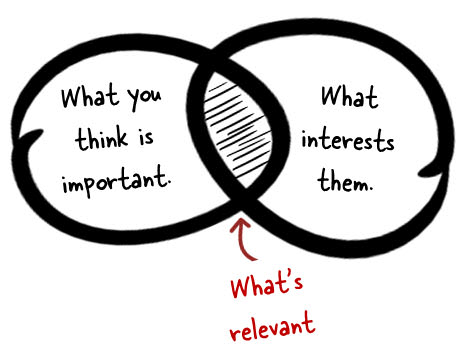-
How To Make Money Off a Passionate Customer
Tue, 15 Dec 2015, in Customers
Customer enthusiasm sure doesn’t come easy.

You have to earn it through trust, listening, empathy and by telling compelling stories.
When most people come across a product, they want to make sure it works and solves their particular problem set. So before that “aha! moment” comes the question, “how will this product help me?” or “are there any companies like mine that use this product?”
If you can’t give people quick answers to these questions, how can they see any value in your brand?
It’s important to look to your existing customers for creative ways to establish trust among your prospective customers. Digging deeper, you’ll realize that people who interact with your product on a regular basis hold a wealth of information that can be reused or reinvented through your various marketing efforts.
Here are some ways you can use engaged customers to drive your brand forward:
First, recognize who they are
People always ask, “What are the best customers?” It’s easy to deduct that a company’s best customers are those elite or platinum plan members who have been spending the most money. But what about those truly excited about your product and go out of their way to tell others about it?
It’s not an easy task for businesses to source out and customers to produce testimonials. Research shows that customers have a tendency to praise in private and complain in public even though on average, users are more likely to talk about positive business experiences than negative ones.
What this means is that customers prefer to share positive experiences on their own Facebook walls, in private messages or emails – which may not be acceptable (read: advantageous) for most businesses. However, when customers voice their discontent, they prefer to use Twitter, word-of-mouth, review sites and other public avenues.
This behavior makes sourcing out and producing authentic testimonials an uphill battle. However, when done well, they provide a very active return on investment while costing little time and money. They’re also a powerful voice for nudging site visitors and fence-sitters in the right direction.
Which leads me to my next point…
Reassure fence-sitters with social proof
Great testimonials give customers the peace of mind to go beyond introduction and right into the familiarity stage. Since the human brain constantly sheds and stores information, we need a way to “remind” our prospects which way to go (I’m talking about the signup and checkout pages).
In the persuasion slide model, the “nudge” can be anything from a call to action or a sign in a store that compels you to enter. However, a simple call to action may not be enough in the online world. The nudge should be powerful, personalized and relevant to your customer’s situation.
Persuaders need to communicate as though they’re constantly pouring sand into a colander. With clear expression, good visuals, and impactful language, your message should highlight the most important takeaways.But how do you get your customers to share their stories? First start within your team: talk with your product managers, sales, marketing and IT departments to see if they can recommend passionate customers buried in their email databases. If you’re part of a small team, this can be accomplished in a matter of days.
After you have a list of solid customers to contact, you’ll need to assign someone to compile an email message that can be used to fish for prospects. You’ll also need a method of pinpointing customers that are eager to share their experiences with your product.
How?
Learn to find customers with a story to tell
People like to hear stories – particularly ones they can relate to in order to understand how a product can fit their needs. Stories usually arise from conversations found in your blog comments, support emails or even on social media such as Facebook, Twitter and Quora.

Now, the all-imposing question: How do you find customers to share these stories?
Here at Helprace we like to tag customer service emails and conversations so that content marketers and outreach representatives can engage with those users at a later date.
Consider using Google Alerts if you’d like to keep tabs site and article mentions. For social media, you can use the social listening site Topsy. It not only searches for Twitter mentions but content (and topics) that are most frequently shared. To maximize exposure, keep track of your:
- Brand name. If you have abbreviations or acronyms in your brand name, make sure to keep track of their mentions, too.
- Competitors. If customers have passionate conversations with your competitors, they may have interesting stories to share with you, too.
- Keywords and messages that are relevant to your industry. You never know where a good story could be lurking!
We also like to use our customer community and browse suggested ideas since they’re shared by some of our most engaged customers.
Now here’s what not to do:
Don’t send mass or poorly timed emails. A mass email may be great marketing to prospects, but they’re going to fall on deaf ears of your active users, much less elicit an excited response. Instead, focus on what your customer wants, what you can do to fill their need and not on what you want them to do.
Hey [someone], this is Edward from Helprace.
I know you’re busy, but in the few months you’ve been using Helprace, I was wondering if you could share your experience with us. I love your brand and its approach to [unique points about company] and I’m wondering how our Helprace modules (ticketing, community, knowledge base) have been used to improve company operations.
I’d like to set up a short (15 minute) interview about [company] at [date and time]. If you’re more comfortable doing this over email, I’ve prepared a few questions for you…
Look forward to hearing from you!
EdwardIt also helps to read up on your customers, what their previous emails were about. In our case a good question would be to ask what support software they were using before. It may also help to create many different variations of the above email depending on what type of customers you have.
Give them some general questions to answer. Get them to talk about their company’s goals and determine how your company fits with them.
For example, if they switched from Zendesk, we will ask why they switched. If it’s because Zendesk was too complicated, we’ll suggest simple Helprace features that may appeal to them.
Think social proof, not platitudes
Avoid reviewers that throw around empty reviews like ”you guys rock!” or “awesome!”. There is nothing that nudges a prospect into becoming a paying customer. There is no practical advice or reason given besides an empty endorsement.
However, when customers reveal how your product helped them solve a specific problem, their voice gains authority – something that will jump out at your readers.
That’s because valuable connections tend to emerge out of social proof. Social proof is nothing more than the inclination of one to rely on the actions of the group to make a decision. In a nutshell, if it’s acceptable for others to give you feedback, your reader will want to do so, too.
Why?
In a 1969 experiment, Milgram found that 4% of passersby would stop to join a single person staring up, however that number jumped to 40% when there were 15 people staring up at the office. On top of this, 86% of passersby would at least look up to see what everyone else was looking at.
If they’re looking at something, there must be something to look at.Online traffic behaves much like these crowds in the street, so it’s very important to create useful information that resonates with the masses.
In Conclusion…
The vast majority of SaaS customers are way too smart for traditional “in-your-face” advertising tactics. There’s always that question at the back of everyone’s minds: How can I justify to myself (or management) that this is the right tool for me? That’s why pointing out enthusiastic, passionate customers is so important – the ones who got more than they paid for. Only they have the power to make your brand shine.
Tags: customers

